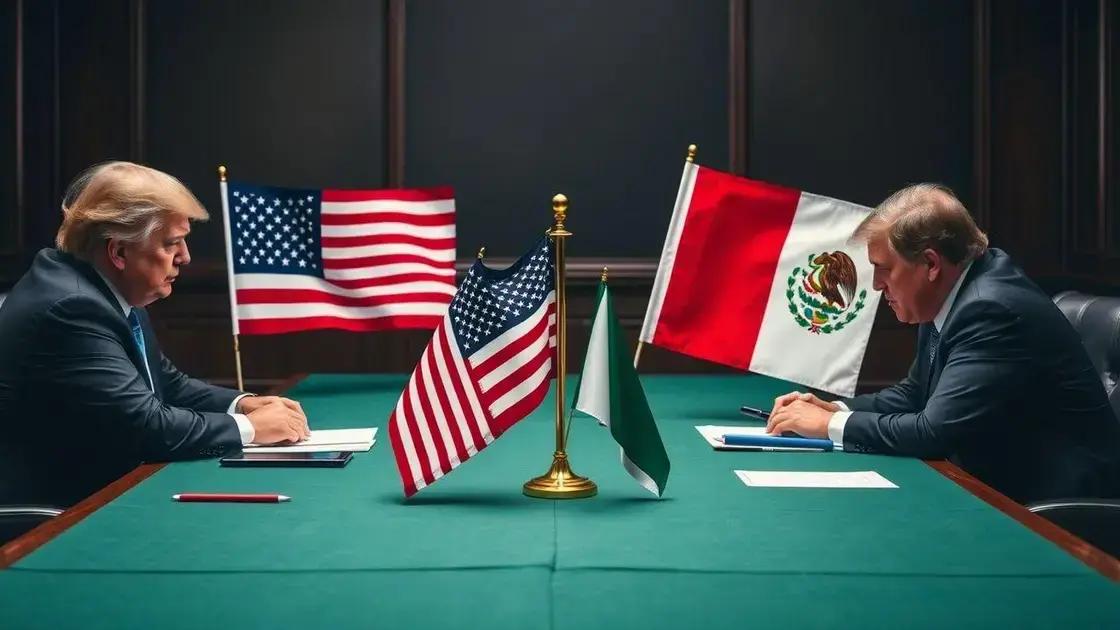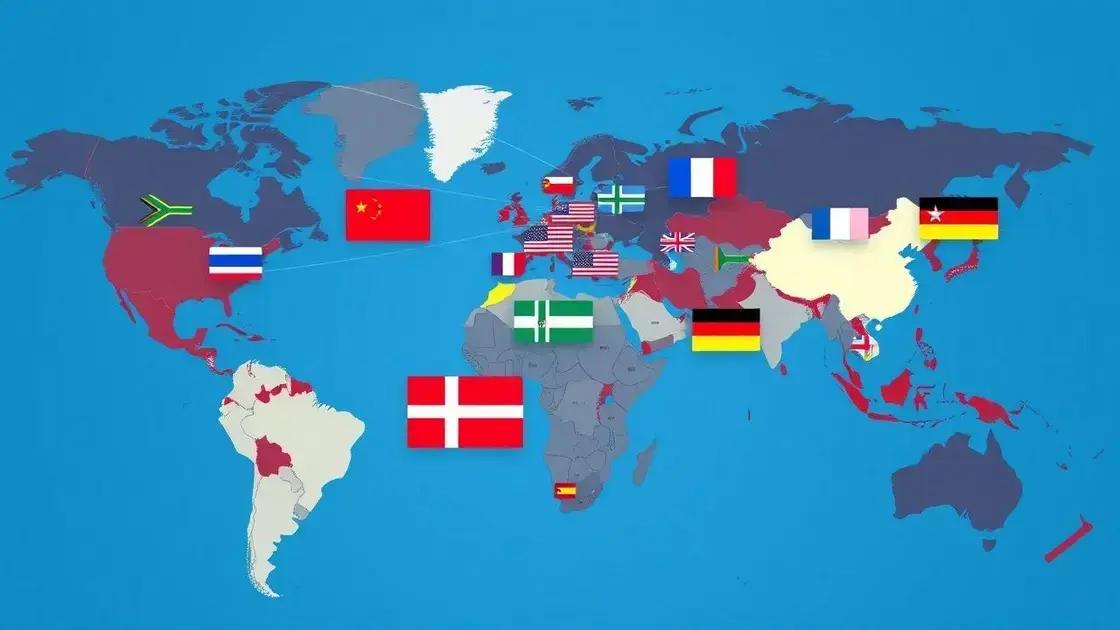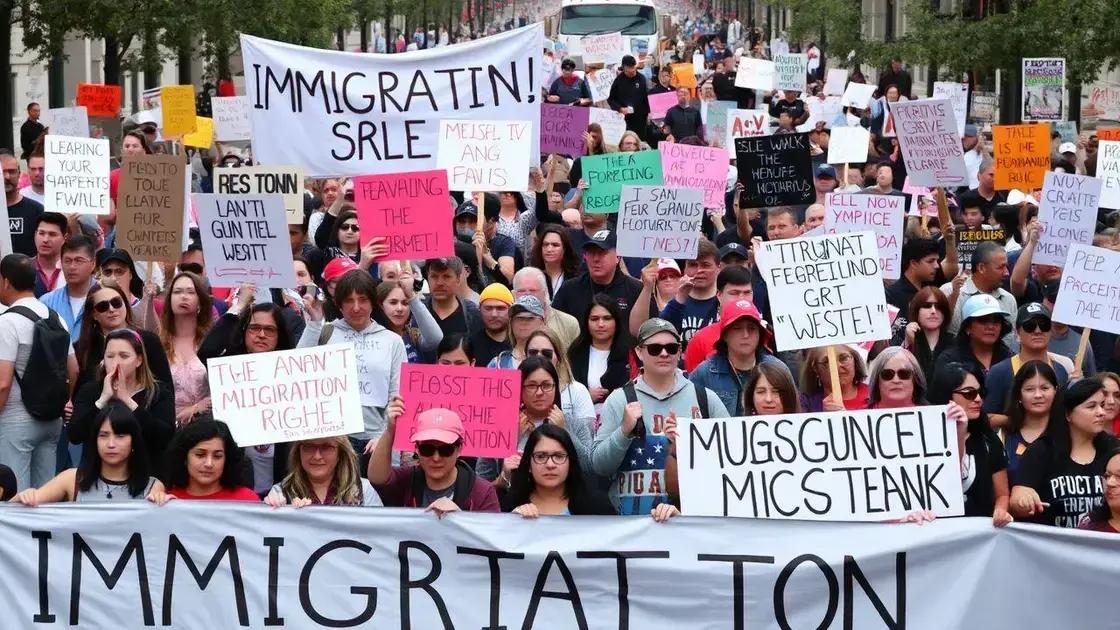Trump escalates tariff threats in ongoing Mexico water dispute

Trump escalates tariff threats in ongoing Mexico water dispute, intensifying economic and social challenges, as both nations grapple with resource management and diplomatic relations that affect trade and community stability.
Trump escalates tariff threats in ongoing Mexico water dispute, igniting discussions on water rights and trade dynamics between the two nations. Have you considered how this could impact you?
Understanding the Mexico water dispute
The ongoing water dispute between the United States and Mexico has stirred significant conversations surrounding resource management. It highlights the importance of understanding the historical context and the current stakes involved. Throughout this article, we will delve into the issues at play and how they affect the relationship between these two nations.
Key Elements of the Dispute
This dispute revolves around the management of water resources from the Colorado River, which is critical for both countries. The river serves as a vital source for agriculture and drinking water. As drought conditions worsen, tensions rise over water allocation.
- Water usage rights
- Effects of climate change
- Impact on local communities
- Legal agreements and treaties
The historical agreements, such as the 1944 Water Treaty, dictate how much water Mexico is entitled to each year. However, discrepancies often arise due to varying interpretations and the changing climate. These factors complicate the relationship and challenge existing frameworks.
Impacts on Communities
Both sides feel the effects of the dispute. In the U.S., states like Arizona and California face their own water shortages, causing concern for farmers and residents alike. Meanwhile, in Mexico, the farmers rely heavily on the provisions outlined in the treaties, leading to protests when water supplies are disrupted.
In addition to economic effects, there are cultural implications as well. Many communities have deep-rooted ties to the land and its resources, so disruptions can affect their lifestyles.
Overall, understanding the Mexico water dispute requires looking at both historical context and current realities. As climate conditions change, the urgency for a sustainable solution grows.
Implications of tariff threats on trade
The implications of tariff threats on trade can have widespread effects on both economies involved. When President Trump escalates tariff threats in ongoing negotiations, it raises concerns among businesses and consumers. Tariffs can increase the cost of goods, affecting pricing and availability.
Effects on Import and Export
Higher tariffs on imports can lead to a decrease in sales for foreign products. This situation creates a ripple effect, impacting local businesses and consumers. Meanwhile, exporters may face challenges in competing in international markets.
- Increased prices for consumers
- Reduced market access for exporters
- Potential job losses in certain sectors
- Encouragement for domestic production
Conversely, some industries might benefit from protectionist policies. Companies that produce domestically may see a rise in demand as foreign products become pricier. This shift can help bolster certain sectors of the economy.
Long-Term Economic Consequences
In the long run, the uncertainty around tariffs can lead to diminished investment. Companies may hesitate to expand or hire new employees, fearing fluctuating costs and market instability. This uncertainty can create an atmosphere of caution among businesses.
Moreover, international relations may suffer as countries react to tariff threats. Nations often retaliate against tariffs, creating a cycle of escalating trade tensions. This cycle complicates efforts toward cooperation and mutual benefit.
Ultimately, the implications of tariff threats on trade are complex. They affect pricing, market dynamics, and international relations, contributing to an uncertain economic future.
Key stakeholders in the water management issue

Key stakeholders in the water management issue involve a diverse group of individuals and organizations. Understanding their roles is crucial for addressing the ongoing water disputes effectively. From government officials to local farmers, each stakeholder plays a significant part in this complex situation.
Government Agencies
Government agencies, both in the United States and Mexico, have a fundamental role in managing water resources. They establish policies, enforce regulations, and negotiate treaties. Often, they must balance local needs with national interests, which can lead to tension.
- Environmental Protection Agency (EPA)
- U.S. Bureau of Reclamation
- Comisión Nacional del Agua (CONAGUA) in Mexico
- State water management authorities
The decisions made by these agencies directly impact water availability for both agricultural and urban use. As they navigate legal frameworks, their actions often spark public debate.
Local Farmers and Communities
Farmers are key stakeholders as they rely heavily on available water for irrigation. They often advocate for more equitable water distribution to ensure their crops can thrive. Moreover, local communities, especially those nearby water sources, are affected by management decisions, making their voices vital in the conversation.
The challenge lies in meeting the demands of these farmers while ensuring sustainability. This balance is essential to developing effective solutions that will benefit both the economy and the environment.
Lastly, environmental groups also engage in this dialogue, advocating for the conservation of water resources and the protection of ecosystems. These groups often highlight the need for responsible water use to preserve biodiversity and natural habitats.
Historical context of US-Mexico relations
The historical context of US-Mexico relations is rich and complex. Understanding this background is crucial to grasp current issues, including the ongoing water dispute. Over the years, both nations have navigated through various challenges and collaborations, shaping their diplomatic ties.
Early Interactions
In the early 19th century, the relationship began to take shape with territorial disputes. The Mexican-American War from 1846 to 1848 resulted in significant land losses for Mexico, altering borders and affecting relations for generations.
- Introduction of new cultural influences
- Expansion of trade relations
- Creation of shared interests in resources
As the years progressed, the countries found common ground in economic partnerships. Trade became a central theme, especially with the establishment of NAFTA in 1994, which strengthened economic ties and fostered closer collaboration.
Challenges and Cooperation
Despite beneficial agreements, challenges remain. Issues such as immigration, drug trafficking, and environmental concerns often strain relations. The water management disputes, particularly regarding the Colorado River, reflect broader concerns over natural resources and bilateral negotiations.
Both countries utilize a variety of treaties to manage shared resources, but disagreements can lead to public discontent. The historical context shows that cooperation and conflict are part of a continuous cycle that shapes diplomatic interactions.
In summary, the relationship between the US and Mexico has evolved through various phases, driven by cooperation, conflict, and mutual dependency on resources and trade.
Potential outcomes of escalated tensions
The potential outcomes of escalated tensions between the United States and Mexico regarding tariffs and water management can have significant implications. As both nations navigate these issues, the consequences can affect various sectors and deepen existing divides.
Economic Impact
One major outcome could be an economic downturn for both countries. Tariff increases often lead to higher prices for consumers. A common concern is that these costs trickle down to everyday goods. A rise in prices could cause consumers to spend less, impacting businesses.
- Increased costs for imports
- Reduction in trade volume
- Slowdown in economic growth
- Potential job losses in affected industries
Furthermore, businesses involved in cross-border trade would likely face uncertainty. This environment can deter investment and hinder expansion, leading to a stagnation of job creation.
Social and Political Ramifications
Escalated tensions could also have lasting social implications. Disagreements over water rights and tariffs might fuel divisions within communities. People may feel the effects of these policies more acutely, leading to unrest or protests as they advocate for their rights.
On a political level, heightened tensions can strain diplomatic relations. Countries may move toward a more adversarial stance, complicating future negotiations on various issues, not just economic ones. The potential for legal disputes over water rights can create lengthy conflicts, drawing public attention and impacting everyday lives.
International relationships are also at stake; allies of both nations may respond to the escalated situation in ways that further affect trade and military agreements. The strain on cooperation could hinder collaborative efforts to tackle shared challenges like climate change and security.
In summary, escalating tensions between the United States and Mexico over tariffs and water management present multiple challenges. The economic impact could be significant, influencing prices and trade. Socially, communities may face unrest, highlighting the importance of cooperation. Politically, strained relations might complicate future negotiations. As both nations navigate these issues, finding solutions will be crucial for long-term stability and mutual benefit.
FAQ – Frequently Asked Questions about US-Mexico Relations and Water Issues
What are the main challenges in US-Mexico water management?
The main challenges include territorial disputes, differing water usage rights, and the impacts of climate change on water availability.
How do tariffs affect the economies of both countries?
Tariffs can raise prices for consumers and reduce trade volume, potentially leading to economic slowdowns and job losses.
Why is cooperation important between the US and Mexico?
Cooperation is crucial for managing shared resources, addressing climate challenges, and ensuring both countries benefit from trade and water access.
What role do local communities play in these disputes?
Local communities often advocate for fair water distribution and can be significantly impacted by management decisions, leading to social unrest if their needs are not met.






